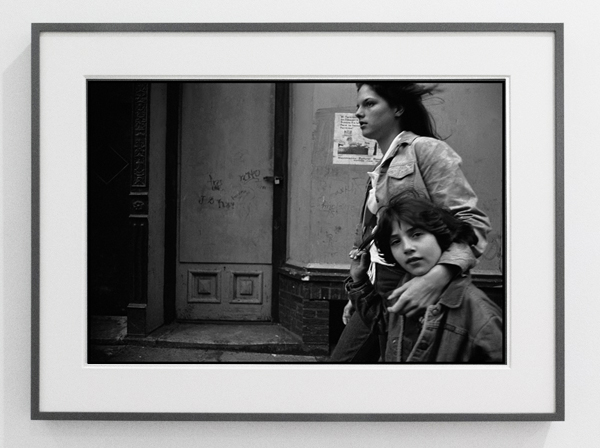JTF (just the facts): A total of 18 black and white photographs, framed in dark grey and matted, and hung against white walls in the main gallery space and the entry area. All of the works are gelatin silver prints, made between 1976 and 1979 and printed recently. Each is sized 16×20 (or reverse) and is available in an open edition. The show also incudes one handwritten note. A monograph of this body of work as recently published by TBW Books (here); it is available in the No. 5 subscription series and as a stand alone title ($40).
Comments/Context: Back in the 1950s and 1960s, the photography of street gangs was decidedly a male endeavor. Bruce Davidson gained the trust of pompadoured teenagers in Brooklyn while Danny Lyon found his way inside a Chicago motorcycle club, and in both cases, the projects evolved into deeper explorations of the communities of young men, where the behavioral nuances of masculine groups and friendships became the central subject.
Susan Meiselas’ overlooked mid-1970s series Prince Street Girls follows this same pattern, but with a complete gender inversion, which gives it a sense of authentic originality when compared with the prevailing tide. In her previous project, the now iconic Carnival Strippers, Meiselas had spent time with the women who performed in striptease acts at small town carnivals across New England and elsewhere, making intimate backstage portraits that told a more complicated story than the leering of the male customers would normally imply. The pictures were frank and honest, and came from a place of genuine care and interest. That approach was enabled by a level of real connection to the women that would have been almost impossible for any male photographer to build.
Prince Street Girls continued this understated gendered point of view, with Meiselas slowly becoming friends with a group of neighborhood girls from Little Italy in New York city. Over a period of several years, she would casually meet the girls in the street or have them stop by her studio, ultimately taking pictures of their impromptu sidewalk gatherings, subway rides, and trips to the beach. The project was once again an engagement with a community that was rooted in the patient development of personal trust, and the antithesis of the snatch and grab visual transactions of most street photography. It would also turn out to be an ongoing opportunity for Meiselas to refine her own artistic voice and develop many of the aesthetic approaches that would later distinguish her work in Nicaragua, Kurdistan, and other distant locales.
Meiselas’ pictures of Dee, Lisa, Carol, Pina, JoJo, and the others are consistently interested in the subtle interactions of the group. The girls are never seen in isolated portraits, but always together, in pairs and clusters where the body language and the facial reactions are what’s intriguing. The earliest pictures revel in togetherness and teenage part-of-the-group conformity – three blown bubbles, a gaggle of schoolgirl kilts, matching striped tops with bare arms, and the repetitions of shoulder length feathered hairstyles. The girls look at each other, size each other up, and casually hang on each other with the sassy tenderness of sisters.
As the years pass, feminine role playing and risk taking enter the mix, from the application of lipstick (with skeptical onlookers) to the smoking of cigarettes. Strappy wedges compete with beat up Converse sneakers, and tube socks are pulled up high and matched with short shorts. And while there are more moments of quiet isolation amid the group in the subsequent pictures, where looks are thrown between friends and factions subtly shift, there is a sense of durable almost familial acceptance in these girls. When they pose together on the hood of a car on Baxter Street, their faces become a kind of tableaux of connection, with multiple overlapping conversations (hands raised, lips surprised, and eyes laughing) taking place all at once. We see them growing up and becoming comfortable with their own sometimes swaggering individuality, while still drawing strength from the group.
In the end, these are pictures that Meiselas made with warmth and affection, and the passing of time has given them a nostalgic edge – it’s hard not to look back and see the details of the poses, and the jean jackets, and the friendships. But the coming-of-age stories of the Prince Street Girls are universal ones, and its these truths that give the photographs their sustained vitality.

